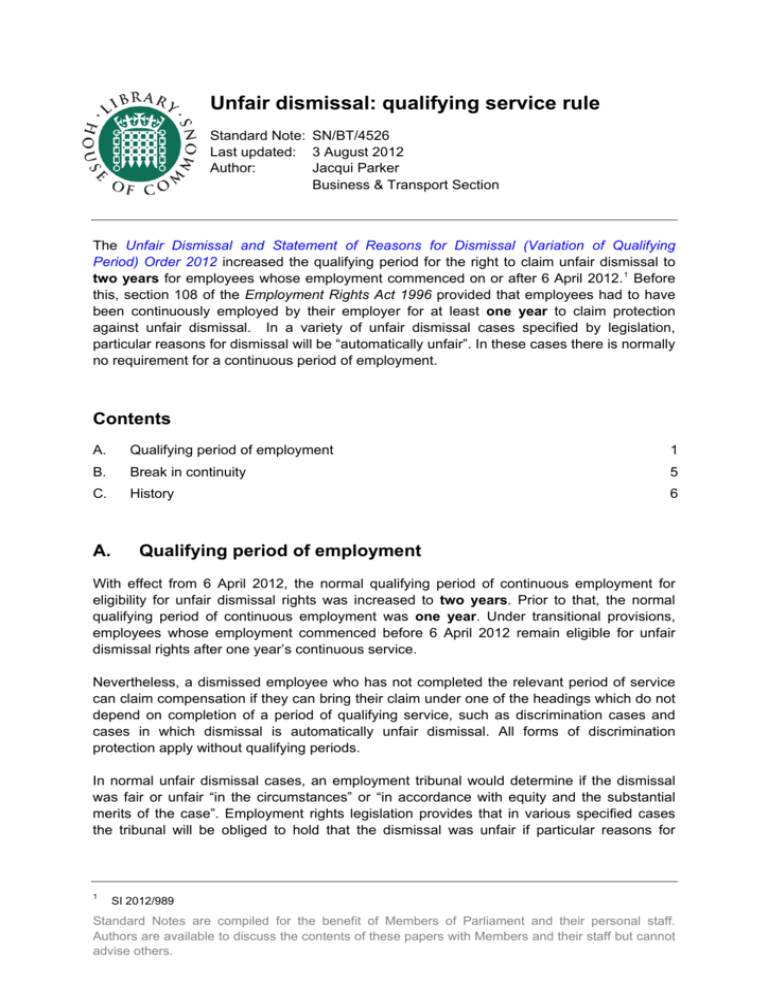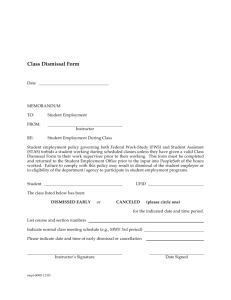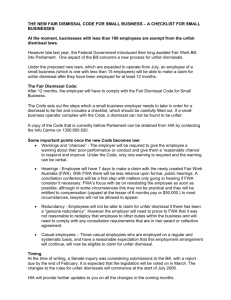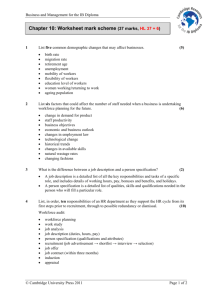Unfair dismissal: qualifying service rule
advertisement

Unfair dismissal: qualifying service rule Standard Note: SN/BT/4526 Last updated: 3 August 2012 Author: Jacqui Parker Business & Transport Section The Unfair Dismissal and Statement of Reasons for Dismissal (Variation of Qualifying Period) Order 2012 increased the qualifying period for the right to claim unfair dismissal to two years for employees whose employment commenced on or after 6 April 2012. 1 Before this, section 108 of the Employment Rights Act 1996 provided that employees had to have been continuously employed by their employer for at least one year to claim protection against unfair dismissal. In a variety of unfair dismissal cases specified by legislation, particular reasons for dismissal will be “automatically unfair”. In these cases there is normally no requirement for a continuous period of employment. Contents A. Qualifying period of employment 1 B. Break in continuity 5 C. History 6 A. Qualifying period of employment With effect from 6 April 2012, the normal qualifying period of continuous employment for eligibility for unfair dismissal rights was increased to two years. Prior to that, the normal qualifying period of continuous employment was one year. Under transitional provisions, employees whose employment commenced before 6 April 2012 remain eligible for unfair dismissal rights after one year’s continuous service. Nevertheless, a dismissed employee who has not completed the relevant period of service can claim compensation if they can bring their claim under one of the headings which do not depend on completion of a period of qualifying service, such as discrimination cases and cases in which dismissal is automatically unfair dismissal. All forms of discrimination protection apply without qualifying periods. In normal unfair dismissal cases, an employment tribunal would determine if the dismissal was fair or unfair “in the circumstances” or “in accordance with equity and the substantial merits of the case”. Employment rights legislation provides that in various specified cases the tribunal will be obliged to hold that the dismissal was unfair if particular reasons for 1 SI 2012/989 Standard Notes are compiled for the benefit of Members of Parliament and their personal staff. Authors are available to discuss the contents of these papers with Members and their staff but cannot advise others. dismissal are established. Colloquially, these are referred to as cases of “automatically unfair” dismissal. Most, but not all, dismissals which are made automatically unfair by relevant legislation require no qualifying period of service at all. The provisions for automatically unfair dismissal can be found mainly in sections 99 – 108 of the Employment Rights Act 1996. Others are found elsewhere in legislation that has conferred separate employment rights. The normal qualifying period is reduced to one month if the dismissal is by reason of a requirement or recommendation specified under section 64(2) ERA, for example contact with dangerous chemicals or exposure to harmful radiation. Section 108 ERA reads as follows: 108 Qualifying period of employment (1) Section 94 does not apply to the dismissal of an employee unless he has been continuously employed for a period of not less than two years ending with the effective date of termination. (2) If an employee is dismissed by reason of any such requirement or recommendation as is referred to in section 64(2), subsection (1) has effect in relation to that dismissal as if for the words two years there were substituted the words “one month”. In sub-section (2) (which reduces the required period to one month) the reasons based on a “requirement or recommendation referred to in section 64(2)” ERA relates to: • Regulation 16 of the Control of Lead at Work Regulations 1980, • Regulation 24 of the Ionising Radiations Regulations 1999 and • Regulation 11 of the Control of Substances Hazardous to Health Regulations 1988 Sub-section (3) then goes on to list a number of cases where the qualifying period is disapplied entirely. Under section 100 of the Employment Rights Act 1996 dismissal is automatically unfair in six specified health and safety cases. This section implemented the EC Health and Safety Framework Directive 89/391 in domestic law. The six cases are as follows: 1. The employee was carrying out or proposed to carry out activities in connection with prevention of health and safety risks at work, having been designated to do so by the employer. This case attracts a minimum basic award of £5,300 if the appropriate date is on or after 1 February 2012. 2. The employee being one of the duly appointed safety representatives on the workforce performed or proposed to perform his duties as such. This case attracts the same minimum basic award as above. 3. The employee was exercising rights under the Health and Safety (Consultation with Employees) Regulations 1996. 2 4. The employee brought direct to the employer's attention (by reasonable means) that circumstances connected with their work were harmful or potentially harmful, provided there was no safety representative or safety committee whose attention could be draw to the matter. 5. The employee left or proposed to leave their place of work because they reasonably believed there was serious and imminent danger which they could not reasonably be expected to avert. 6. The employee took or proposed to take appropriate steps to protect themselves or others from danger which they reasonably believed to be serious and imminent, unless those steps were so negligent that dismissal would be justified. By virtue of section 108(3)(c) of the Employment Rights Act 1996 (ERA) no period of service qualification is needed in such cases. Separate provisions make victimisation automatically unfair in the same six cases (section 44). In addition to the various health and safety grounds outlined above, the various cases where a dismissal will be automatically unfair are as follows: • assertion of statutory rights – dismissal on grounds of "assertion of a statutory right". Relevant statutory rights for this purpose are defined in section 104(4) ERA • fixed term contracts – dismissal for exercising or attempting to exercise rights under the Fixed-Term Employees (Prevention of Less Favourable Treatment) Regulations 2002, SI No.2034 for employees who work under fixed-term contracts • flexible working arrangements – dismissal for making (or proposing to make) an application for flexible working arrangements • improper selection for redundancy – under section 105 ERA, selection for redundancy for a reason which unfair dismissal law treats as automatically unfair dismissal, subject to the condition that "the circumstances constituting the redundancy applied equally to one or more other employees in the same undertaking who held positions similar to that held by the employee and who have not been dismissed by the employer" • jury service – dismissal for taking time off work for jury service • maternity and pregnancy – (in addition to the normal sex discrimination protection) dismissal for any of the reasons or circumstances set out in "regulations made by the Secretary of State" concerning pregnancy, childbirth, maternity or maternity or parental leave or taking time off for ante-natal care; or where an employer who has failed to give an employee the required notice of the date on which her maternity leave will end then dismisses her for not returning to work on the correct date • adoption leave – an employee is dismissed because they took or sought to take adoption leave or were selected for redundancy for that reason • parental leave – dismissal for relying on the various rights for working parents: parental leave; time off for dependents; paternity or adoption leave • part time workers – dismissal for asserting rights under the Part-time Workers (Prevention of Less Favourable Treatment) Regulations 2000 SI No.1551 3 • membership or non-membership of a trade union – dismissal of an employee, including selection for redundancy, on grounds related to union membership • industrial action – dismissal for involvement in industrial action during the 12 weeks (formerly 8 weeks) of “protected industrial action” under section 238A of the Trade Union and Labour Relations (Consolidation) Act 1992 • information and consultation regulations – dismissal for exercising rights under the Information and Consultation of Employees Regulations 2004 SI No.3426 • information and consultation rights - dismissal in connection with information and consultation rights of occupational and personal pension scheme members (Occupational and Personal Pension Schemes (Consultation by Employers and Miscellaneous Amendment) Regulations 2006 • information and consultation rights – dismissal in connection with such rights in respect of European Cooperative Societies (European Cooperative Society (Involvement of Employees) Regulations 2006 SI 2006/2059 • information, consultation and negotiations rights – dismissal in connection with such rights of employees involved in cross-border mergers (Companies (CrossBorder Mergers) Regulations 2007 SI 2007/2974 • information, consultation and negotiation rights - dismissal in connection with such rights of employees of European public limited liability companies (European Public Limited-Liability Company (Employee Involvement) (Great Britain) Regulations 2009 SI 2009/2401 • employee representatives – dismissal for performing or proposing to perform any functions as an employee representative or candidate for election in respect of employees’ rights to be consulted in the event of proposed multiple redundancies or sale/transfer of the employing business • National Minimum Wage – dismissal in connection with an attempt to exercise any right under the National Minimum Wage Act or seek enforcement of the National Minimum Wage • pension fund trustees – dismissal for performing (or proposing to perform) functions as an appointed trustee of a relevant occupational pension scheme • pension enrolment – dismissal in connection with pension enrolment. Section 104D (added by virtue of the Section 57 Pension Act 2008). • recognition of trade union – dismissal for a reason relating to obstruction or promotion of official recognition of a trade union • retirement – dismissals where the employer failed to comply with its obligations under the statutory retirement procedure • right to be accompanied at disciplinary or grievance hearing or a meeting under the statutory retirement procedure – dismissal for relying on the right to be accompanied by a fellow worker or trade union representative at internal disciplinary and grievance procedure hearings • right to request study and training – Section 104E ERA and Reg 18(4) Employee Study and Training (Procedural Requirements) Regulations 2010 SI 2010/155 • spent conviction - dismissal because of a spent conviction within the meaning of the Rehabilitation of Offenders Act 1971 unless the employee falls within a category excluded from the Act by statutory order. • Sunday work – dismissal of a shop or betting worker because they refuse to work on Sunday (section 101 ERA) 4 • taking part in union activities – dismissal if the principal reason was that the employee "had taken part, or proposed to take part, in the activities of an independent trade union at an appropriate time" (TULRCA 1992, s.152(1)(b)) • tax credits – dismissal if the principal reason relates to a claim for tax credit (ERA 1996 s.104B) • Time off for dependents – dismissal in connection with time off for dependents under section 57A ERA – Section 99 ERA. • TUPE transfer – dismissal for a reason connected with a sale or other transfer of a business covered by the Transfer of Undertakings (Protection of Employment) Regulations 2006 SI No.246 • Trade union blacklist – dismissal for a reason relating to a trade union blacklist prohibited under the Employment Relations Act 1999 (Blacklists) Regulations 2010 SI 2010/493 • whistleblowing – dismissal for making a protected disclosure under the Public Interest Disclosure Act 1998 • working time regulations – dismissal for asserting rights under the Working Time Regulations 1998, SI No.1833 A further addition to the list of automatically unfair reasons for dismissal that has been added to the ERA but which is not yet in force is: • education and training - dismissal of an employee under age 18 for exercising or proposing to exercise rights to participate in education or training Section. 101B ERA (added by virtue of the Education and Skills Act 2008) B. Break in continuity Normally, "continuous employment" must be with the same employer throughout 2 or with an associated employer. 3 However, continuity of employment is not broken on sale or other transfer of ownership of the employing business even though this results in a change of employer. 4 These provisions are now contained in section 139(2) ERA. The rules only apply to private sector employers. Under the Local Government (Early Termination of Employment) (Discretionary Compensation) (England and Wales) Regulations 2006, SI 2006/2914 special provision is made to preserve statutory redundancy pay rights of public sector employees, including local authority staff, if their employment is transferred from one public sector employer to another as they cannot take the benefit of the associated employer rules which apply in the private sector (section 139(2) ERA). These regulations do not give any rights to claim unfair dismissal beyond the normal rules in the Employment Rights Act 1996. 2 3 4 Section 218(1) ERA Section 218(6) ERA Section 218(2) – (5) ERA 5 C. History The right to claim unfair dismissal was introduced by the Industrial Relations Act 1971. At that time the qualifying period was two years. 5 This was reduced to one year in 1974 and to six months in 1975 by the Trade Union and Labour Relations Act 1974. 6 It was increased again to one year in 1979 by the Unfair Dismissal (Variation of Qualifying Period) Order 1979 SI No 959 and to two years for employees in firms with fewer than 21 employees in 1980 under the Employment Act 1980. Finally, it was raised to two years in all cases in 1985 by the Unfair Dismissal (Variation of Qualifying Period) Order 1985 SI No 782. Originally, the only people able to claim unfair dismissal were those who worked 21 hours or more a week. 7 The Employment Protection Act 1975 reduced this to 16 hours a week and allowed part-time workers who worked between 8 and 16 hours a week to claim the right after five years' service. 8 On 3 March 1994, the House of Lords ruled that this law amounted to indirect discrimination against women as so many more women than men work under 16 hours a week. It was, therefore, incompatible with EC law. 9 The Government eventually laid a Statutory Instrument which amended the Employment Protection (Consolidation) Act 1978 to take account of this judgment. 10 It removed all references to hours worked from the Act so that all employment rights now apply equally whatever hours are worked. The rights cover not only unfair dismissal but other rights, notably the right to a redundancy payment and to extended maternity leave. In R v Secretary of State for Employment ex parte Seymour-Smith and Perez, the Court of Appeal ruled that the two year qualifying period was discriminatory in certain circumstances. 11 Ms Seymour-Smith and Ms Perez were both dismissed in May 1991 after having been employed for fifteen months by their employers. The Unfair Dismissal (Variation of the Qualifying Period) Order 1985 12 had increased the qualifying period for unfair dismissal claims from one to two years' service, so both women had insufficient service to take their case to an industrial tribunal. The women applied for judicial review in the High Court, and sought orders quashing the 1985 Order and declaring it incompatible with the EC Equal Treatment Directive. 13 Their argument was that fewer women than men were able to meet the two year qualifying rule; that there was no objective justification, unrelated to sex, for the rule; and that it therefore breached the Directive's prohibition on indirect discrimination against women in employment. In February 2000, the House of Lords, after taking into account the equivocal decision of the ECJ, ruled against the employees. They agreed that the two year qualification period rule was indirectly sex discriminatory but held that at the time of dismissal in 1991 a two year qualification period for acquiring unfair dismissal rights had been objectively justified on the grounds that had there not been a two year qualification period in a time of recession 5 6 7 8 9 10 11 12 13 Section 28 Schedule 1, para 10 Industrial Relations Act 1971, s27(1)(f) Schedule 16, Part II, para 14 - brought into force on 1 February 1977 by the Employment Protection Act 1975 (Commencement No 6) Order 1976 SI No 1996 Regina v Secretary of State for Employment ex parte Equal Opportunities Commission and Another The Employment Protection (Part-time Employees) Regulations 1995, SI No 31 Court of Appeal, 31 July 1995 SI 1985 No 782 76/207/EEC 6 employers would not have taken on new staff. 14 In any event, the Labour Government decided to reduce the qualification period from two years to one year and this was given effect by the, Unfair Dismissal and Statement of Reasons for Dismissal (Variation of Qualifying Period) Order 1999. The Coalition Government’s set out its intention undertake an employment law review in the Coalition Agreement. Subsequently in May 2011, the Department for Innovation and Skills issued a consultation, Resolving Workplace Disputes, which considered a number of matters including increasing the qualifying period of employment. In November 2011 the Government set out its rationale for increasing the qualifying period of employment in its response to the consultation: While there are clearly divergent views on the merits of the proposal, we consider that business stakeholders are best placed to evaluate the likely impact on business confidence. Improving business confidence (and the economic benefits which would flow from such an improvement) is a key aim of Government policy. As well as a positive impact on business confidence, we consider that there is a potential secondary benefit for employees recruited into roles with a high training requirement (where there may be a risk of employers taking a cautious approach and dismissing employees before they qualify for the right not to be unfairly dismissed, if there is uncertainty that they will achieve the required standard). The extension of the qualifying period is also consistent with the general aim set out in the RWD consultation of reducing the number of tribunal claims. However, in light of the consultation, we have revised down our estimate of the number of claims that will be saved. This is because we are now assuming that all claims currently under multiple jurisdictions (and including an unfair dismissal claim) will proceed under the other jurisdiction(s). We had previously assumed that half of such claims would be withdrawn. This means that the measure is now expected to result in a reduction in tribunal claims of between 2,100 - 3,200 claims, representing 4% - 7% of all unfair dismissal claims. When the wider impact of early conciliation is taken into account, the impact decreases further so that we can expect a reduction of around 1,600 – 2,100 claims. The detail of this change is set out in the Impact Assessment. We are unconvinced by arguments made by some respondents to the consultation that there could be widespread substitution of current unfair dismissal claims into other jurisdictions, such as discrimination. There is little evidence that, where there are grounds for a discrimination claim, individuals are currently choosing to pursue an unfair dismissal claim instead. Furthermore, other Resolving Workplace Disputes proposals aim to encourage early resolution of disputes (for example, greater use of pre-claim conciliation). This will help to avoid weak claims from being pursued in other jurisdictions. As detailed in the Equality Impact Assessment, there is a degree of disparity of impact from extending the qualifying period. However, the Government does not consider that, an extension of the unfair dismissal qualifying period would cause a considerable disparity of impact on any particular group. Furthermore, we believe that extending the qualifying period is a proportionate means of achieving the legitimate aim of improving business confidence to recruit and retain staff. We are committed to assessing the 14 See SN/BT/252 for detailed background on the Seymour-Smith case 7 impact of policy changes and we will monitor the impact, including the equality impact, of this proposal as part of our overall assessment of the implementation of the Resolving Workplace Dispute proposals. As set out in the Impact Assessment, the Government has considered the alternative option of extending the qualifying period only for small businesses. However, there does not appear to be strong evidence that small businesses are disproportionately affected by unfair dismissal rules. Data from a 2008 Survey of employment tribunal claimants shows that 34% of unfair dismissal claims involve businesses with fewer than 50 employees, whereas such businesses employ 37% of the workforce. There was no pattern in responses to consultation to suggest small firms are more concerned about the qualifying period. Furthermore, extending the qualifying period only for small businesses would reduce the benefits associated with this proposal. The Government has therefore decided to go ahead with extending the qualifying period for all businesses. 15 15 http://www.bis.gov.uk/assets/biscore/employment-matters/docs/r/11-1365-resolving-workplace-disputesgovernment-response.pdf 8






